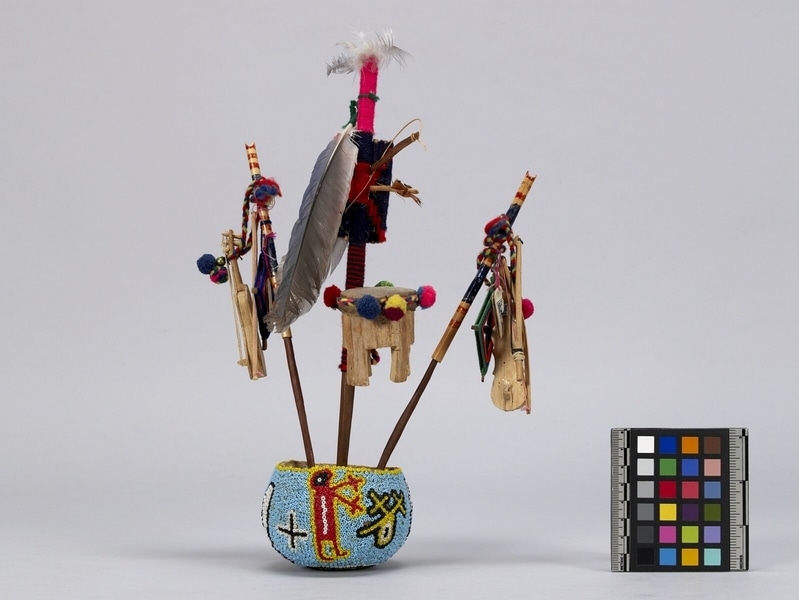Votive Bowl Item Number: Ni27 a-f from the MOA: University of British Columbia





Description
Hollowed gourd bowl covered on exterior with beeswax and inlaid with glass beads in a design consisting of white deer with cross above centre of body, red and black undulating line at centre of body, outlined in black. Two red and yellow figures both with arms outstretched, one is seated on a white and black chair the other is standing. Two u-shaped bases have double crosses above with blue ground, and yellow rim. Black divided circle on base has green and white triangular shaped wedges. Bowl contains three sticks inserted into beeswax. Two sticks are painted in blue and red bands, notched at upper end. Centre stick wrapped in red, blue, and pink yarn. Diminutive representations attached to each stick with braided or wrapped yarn, stick on left has a guitar, two bows, god's eye, paper sandal. Centre stick has drum, bow, arrow, shield, and feathers. Stick on right has violin, bow, god's eye and a paper sandal.
History Of Use
Votive bowl, arrows, and attachments signify the supplicant's specific need/desires to specific gods; style of arrows and each attachment serves specific purpose.
Cultural Context
contemporary; tourist art; ritual
Iconographic Meaning
Musical instruments signify luck in singing/playing; sandals in dancing, arrows and bows in hunting deer.
Narrative
The Wixáritari are known to the larger world as the Huichol, however that is not the name they use to refer to themselves.
Item History
- Made in Jalisco, Mexico and Nayarit, Mexico before 1980
- Collected during 1980
- Owned by Cicuri Shop
- Owned by Ralph Maud before February 1, 1982
- Received from Ralph Maud (Seller) and Museum of Anthropology Shop Volunteers (Funding source) on February 1, 1982
What
- Name
- Votive Bowl
- Identification Number
- Ni27 a-f
- Type of Item
- bowl
- Material
- hair, feather, synthetic fibre ?, cotton fibre ?, wood, glass, bee wax and gourd fruit
- Manufacturing Technique
- cut, hollowed, applied, folded, knotted, plied, pegged, painted, wrapped, inserted, carved and moulded
- Overall
- height 33.0 cm, width 22.0 cm, depth 13.0 cm
Who
- Culture
- Huichol
- Previous Owner
- Cicuri Shop and Ralph Maud
- Received from
- Ralph Maud (Seller) and Museum of Anthropology Shop Volunteers (Funding source)
Where
- Holding Institution
- MOA: University of British Columbia
- Made in
- Jalisco, Mexico and Nayarit, Mexico
When
- Creation Date
- before 1980
- Collection Date
- during 1980
- Ownership Date
- before February 1, 1982
- Acquisition Date
- on February 1, 1982
Other
- Item Classes
- beadwork
- Condition
- good
- Accession Number
- 0774/0028 a-f